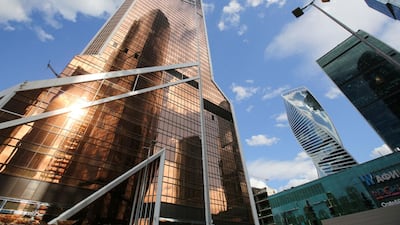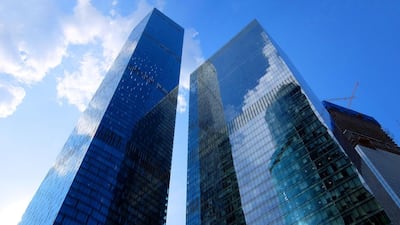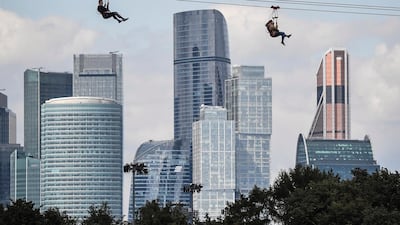More than 200 years ago, three English businessmen raised the then substantial sum of £17,000 to build a huge new mill on the outskirts of the market town of Shrewsbury.
The architect, Charles Bage, proposed a radical new design: instead of being supported by bricks, the walls and floors would be constructed of iron beams and columns, allowing the building to rise to a remarkable five storeys.
This lightweight construction allowed open floor spaces and airy windows, with the added advantage of being almost fireproof. And so, in 1797, the modern skyscraper was born.
At the time, the world’s tallest building was the 14th Century Strasbourg Cathedral and although Europe took the title of the tallest man made structure with the Eiffel Tower in 1889, it has never again claimed any world records.
As the New York cityscape was transformed by skyscrapers in the 1930s, Europe remained resolutely low rise.
The exception was the Soviet Union, where tall buildings were seen as a response to capitalist America.
The never-completed 495 metre high Palace of the Soviets, topped with a huge statue of Lenin but abandoned after the Second World War, is the ultimate expression of this ideology.
Today, most of Europe’s tallest buildings are still in Russia, with only London and Istanbul making the top ten.
Few of Europe’s cities have buildings that surpass 300 metres, meaning they are shorter than the Eiffel Tower.
Paris has the 231 metre Tour First and Frankfurt the 239 metre Commerzbank Tower.

In England, though, the flax mill at Ditherington, Shrewsbury still stands. Now a Grade 1 listed building, which ranks alongside the Tower of London and Buckingham Palace, the mill is currently undergoing renovation.
It is hoped to reopen next year as a historic monument, but also with office space to rent. The grandfather of the skyscraper is back in business.
*Source: Skyscrapercenter.com
Here are the 10 tallest buildings in Europe:
- Lakhta Centre, St Petersburg, 462 metres
- Federation Tower, Moscow, 373 metres
- OKO Residential Tower, Moscow, 354 metres
- Neva Towers, Moscow, 345 metres
- Mercury City, Moscow, 338 metres
- The Shard, London, 309 metres
- Eurasia Tower, Moscow, 308 metres
- Capital City Moscow Tower, Moscow, 301 metres
- (and 10) Skyland Residential and Office Towers, Istanbul, both 284 metres
1. Lakhta Centre, St Petersburg
Height: 462 metres
Completed in 2019, this is Europe’s tallest building and the world’s most northern skyscraper. A mixed use structure, it will become the HQ of energy giant Gazprom. Objections that it would overshadow St Petersburg's historic centre saw it moved far outside the city to the coastal Lakhda district, overlooking the Baltic sea. It was originally designed by Edinburgh-based RMJM, which also worked on Dubai's DIFC and Abu Dhabi's leaning Capital Gate tower.
2. Federation Tower, Moscow
Height: 373 metres
People slide along a zipline over the Moskva river in front of Moscow's financial district, with Federation Tower in the centre. Construction began in 2005, but the financial downturn meant it was not completed until 2017. The original design included a spire that would have taken the height to 450 metres, but this was dismantled before completion.
3. OKO Residential Tower, Moscow
Height: 354 metres
Short for Ob"yedinonnyye Kristallom Osnovaniya, the abbreviation is also the Russian for “eye”. Part of a complex that includes the 254 metre South Tower. The North Tower, completed in 2015, has a rooftop skating rink that is Europe’s highest.
4. Neva Towers, Moscow
Height: 345 metres
Still only partly completed, the complex of two skyscrapers will eventually include the shorter Tower 1, at 302 metres when finished, making it Europe’s eighth tallest building. The site was originally intended for the Russia Tower, a Norman Foster design that would have been 612 metres, but which was cancelled after the 2008 financial crisis.
5. Mercury City, Moscow
Height: 338 metres
Once Europe’s tallest building when it was finished in 2013. Clad in copper coloured reflective glass, it was designed to collect melting snow for water use as an environmental measure.
6. The Shard, London
Height: 309 metres
Rising on the south bank of the Thames, Renzo Piano’s distinctive design has as many detractors as admirers for its impact on the London skyline. Opened in 2012, The Shard has featured in Spider-Man: Far From Home and an episode of Dr Who. To give a sense of scale, it is 11 metres shorter than Dubai's 320 metre Burj Al Arab.
7. Eurasia Tower, Moscow
Height: 308 metres
The seventh tallest building in Europe ranks just 141st in the world. Completed in 2014, Eurasia Tower includes 20 luxury apartments, a hotel, shops and is part of cluster of high rise buildings that includes the Federation Tower and OKO complex.
8. Capital City Moscow Tower, Moscow
Height: 301 metres
Moscow dominates much of our list. Capital City Moscow Tower is part of the 'City of Capitals', a high-rise complex in the Russian capital's business district. Moscow Tower was the tallest building in Europe on completion in 2009 and sits next to the 256 metre St Petersburg Tower.
9. Skyland Residential and Office Towers, Istanbul
Height: both 284 metres
The twin towers take our joint ninth place. Completed in 2017, they are the tallest in Istanbul, which now has the second highest number of buildings over 150m after Moscow. The mixed- use complex features a hotel and conference centre, while the residential tower features over 800 residences.
A version of this article was first published on October 12, 2020










